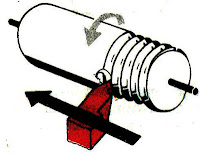Basic Design Techniques
The forging problem can be summarized as to find the best process design, which makes it possible to form the required part. We do not consider the preliminary problem of dressing. We assume that the
forged part has already been designed out of the shape of the final part, which will often be obtained after machining. The problem is just to design a deformation path for the material in order to obtain a prescribed shape with satisfactory properties and for the lower cost. Of course, the deformation paths are not unique, and that can include several forging operations. So the problem is to find the best shapes of the preforming tools, the best forming temperatures (both the initial temperature of the billet and the temperature of the dies), the best forging velocities, the best lubricant and lubrication conditions, etc.
The optimality conditions regard several parameters which may depend on the process itself. However,
most of the time, the optimal forging design has to obtain the right final part without major defects such as folds, to minimize the number of operations, to minimize the size of the initial billet, to reduce the maximum forging force during the operations, and so on.
This is a complex design problem as often the material flow is three-dimensional and difficult to foresee. It is not possible to simplify it into a less complex problem which could be more easily studied. In fact, in this area, there is a deep lack of simple mathematical models. Just a few problems can be analytically solved, such as the upsetting of a cylinder (or a bar) between flat dies without friction. Although it provides some interesting tendencies, it is far too simple to be useful for the design of a close-die forging process. So, the industrial practice was mainly based on thumb rules and empirical knowledge which have been obtained either by actual experiences, by reduced scale or simulation experiments, or by more complex mathematical models [51, 2].
Some approximated models and methods have been developed, for instance by Chamouard [11], in order to predict the filling of the forging dies and the forging force. Unfortunately, they are not easy to use. In order to bring them within the reach of these persons, recently, the Chamouard’s approach has been incorporated into computer software [56]. However, according to the present computer performances and the restricting hypothesis of such models, this is probably not the most efficient and modern way to simulate the process, as we shall see.
As a matter of fact, all the proposed methods are restricted to two-dimensional (axisymmetrical or plane strain approximation) problems. For complex three-dimensional flows, the 3D problem has first to be decomposed into several 2D plane strain problems (see Fig. 5.1), which is both not easy and not always possible.
COMPUTER-AIDED DESIGN,
ENGINEERING, AND MANUFACTURING
Systems Techniques And Applications
VOLUME
V I
Editor
CORNELIUS LEONDES
Boca Raton London New York Washington, D.C.
CRC Press
MANUFACTURING
SYSTEMS PROCESSES
















